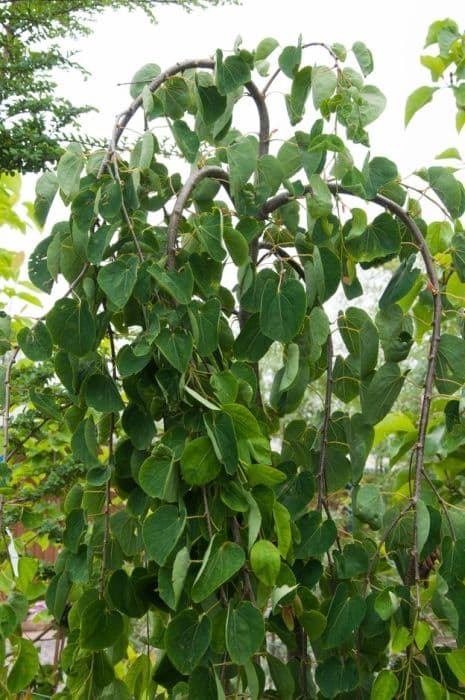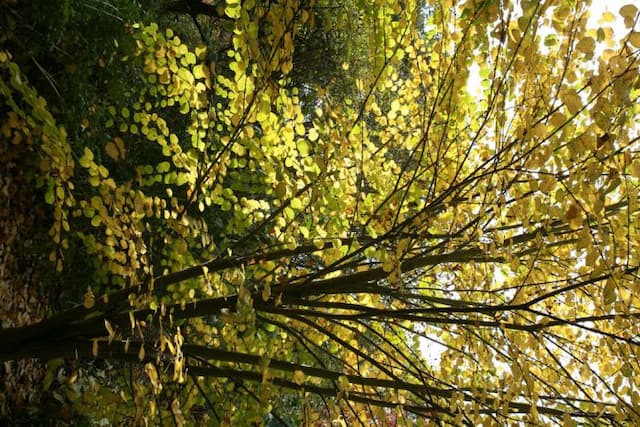Katsura Cercidiphyllum japonicum 'Rotfuchs'

ABOUT
The plant known as Katsura, specifically the 'Rotfuchs' variety, is renowned for its striking foliage which presents a visual treat across seasons. In spring, the round to heart-shaped leaves emerge with a reddish-purple tint, providing a vibrant splash of color. As the leaves mature, they transition to a blue-green for the summer months, maintaining visual interest. The Katsura 'Rotfuchs' is particularly admired for its autumn display when the leaves turn to an impressive array of yellows, oranges, and sometimes a striking reddish-purple, seeming to echo the fiery palette of fall. Moreover, when the leaves begin to fall, they emit a sweet fragrance, often likened to burnt sugar or cotton candy, hence enhancing not just the visual but also the olfactory experience of the season. The plant is gracefully structured with a weeping form, sporting branches that drape down elegantly, adding to its ornamental value and making it a cherished addition to any garden setting. Overall, Katsura 'Rotfuchs' is valued for its distinct and changing leaf colors, sweetly scented autumn display, and weeping habit, all contributing to its allure as a landscape plant.
About this plant
 Names
NamesFamily
Cercidiphyllaceae.
Synonyms
Red Fox Katsura Tree, Rotfuchs Katsura.
Common names
Cercidiphyllum japonicum 'Rotfuchs'.
 Toxicity
ToxicityTo humans
Katsura tree is not known to be toxic to humans. There are no well-documented cases or reports of poisoning from ingesting any part of this plant. As with any plant material, individual allergies or sensitivities could cause reactions, but the Katsura tree is generally considered safe around humans with no significant concerns regarding toxicity.
To pets
Katsura tree is not known to be toxic to pets. It is not listed on common toxic plant databases for dogs and cats, and there are no standard reports of poisoning from this plant in household pets. As such, if a pet were to ingest parts of the Katsura tree, it is not expected to experience symptoms of poisoning. However, consuming any non-food plant matter might cause mild gastrointestinal upset in some animals due to the physical irritation or sensitivity.
 Characteristics
CharacteristicsLife cycle
Perennials
Foliage type
Deciduous
Color of leaves
Varies
Height
20-30 feet (6-9 meters)
Spread
15-20 feet (4.5-6 meters)
Plant type
Tree
Hardiness zones
4-8
Native area
Japan China
Benefits
 General Benefits
General Benefits- Ornamental Value: Cercidiphyllum japonicum 'Rotfuchs', commonly known as Katsura tree, offers aesthetic appeal with its heart-shaped leaves that change colors seasonally.
- Shade Provision: The Katsura tree can grow to a substantial size, providing shade in gardens and parks, which can be particularly valued in urban settings.
- Fall Color: It is renowned for its striking autumn foliage, which transforms into vibrant shades of yellow, orange, and red, providing a spectacular display.
- Spring Interest: Its emerging reddish-purple leaves in the spring add early color to landscapes after the winter season.
- Nature Habitat: The tree can serve as a habitat and food source for wildlife, including caterpillars of certain moth species.
- Low Maintenance: The Katsura tree is relatively low maintenance once established, requiring minimal pruning and care.
- Deciduous Advantage: Being deciduous, it allows sunlight through in winter months while providing ample canopy during summer, making it beneficial for seasonal landscaping strategies.
 Medical Properties
Medical PropertiesThis plant is not used for medical purposes.
 Air-purifying Qualities
Air-purifying QualitiesThis plant is not specifically known for air purifying qualities.
 Other Uses
Other Uses- Culinary Sweetening: The leaves of the Katsura tree, when they fall and decompose, have a distinct sweet smell reminiscent of burnt sugar or cotton candy, which can inspire culinary creations with a similar aroma profile.
- Photography and Art Subjects: Its unique reddish-purple foliage provides an exceptional addition to landscape photography, and its overall shape and color variations can inspire artists in their natural-themed artwork.
- Bonsai: The Katsura tree's beautiful coloration and leaf shape make it an interesting species for the art of bonsai, especially in regions where traditional bonsai species may not thrive.
- Education and Research: Often used in botanical gardens and arboreta for educational purposes to demonstrate tree growth, leaf cycles, and color change through the seasons.
- Nature-Inspired Design: Its striking appearance in different seasons can be used by designers as a model for color schemes in fabric, wallpaper, or even in architectural elements.
- Fragrance Inspiration: The sweet scent of the Katsura tree's leaves can inspire perfumers to create new fragrances, particularly autumnal scents.
- Seasonal Celebrations: Branches and leaves can be used for decorative purposes in fall displays or events, aligning with the tree's color change to create a thematic ambiance.
- Woodworking and Carpentry: Although not commonly used for lumber, the wood of the Katsura tree can be utilized in woodworking for small projects requiring soft, easily workable wood.
- Feng Shui: The Katsura tree might be integrated into Feng Shui garden design, as its seasonal transformation is in line with the philosophy of changing energy and balance with nature.
- Soundscaping: The rustling of the heart-shaped leaves as the wind blows through can be a deliberate aspect of landscape design for calming sound effects in gardens or parks.
Interesting Facts
 Feng Shui
Feng ShuiThe Katsura tree is not used in Feng Shui practice.
 Zodiac Sign Compitability
Zodiac Sign CompitabilityThe Katsura tree is not used in astrology practice.
 Plant Symbolism
Plant Symbolism- Transient Beauty: The Katsura tree, known for its heart-shaped leaves and beautiful autumn colors, symbolizes the fleeting nature of beauty and life, as its leaves change color quickly and drop early.
- Nostalgia: The sweet scent of the Katsura tree's leaves in autumn is reminiscent of burnt sugar or cotton candy, evoking a sense of nostalgia for childhood or simpler times.
- Elegance: With its graceful shape and delicate foliage, the Katsura tree is often associated with elegance and poise, reflecting a serene and refined beauty.
- Renewal: As a deciduous tree that presents a breathtaking color transformation each year, the Katsura tree symbolizes renewal and the cycle of life.
 Water
WaterThe Katsura Tree should be watered deeply to ensure moisture reaches the root zone; ideal watering would be equivalent to 1 inch of rainfall per week. During the growing season, if there is no rain, water the tree once a week using roughly 15 gallons for a young tree to establish a good root system. Mature trees will require less frequent watering, but ensure that they receive at least 15 gallons every two to three weeks during dry spells. Avoid overwatering, as the Katsura Tree does not like to sit in waterlogged soil. In winter, reduce watering but make sure the root ball does not dry out completely.
 Light
LightThe Katsura Tree thrives best in full sun to partial shade. It should be planted in a spot that receives at least four to six hours of direct sunlight daily, combined with some dappled afternoon shade to protect it during the hottest part of the day. Avoid deep shade, as this can hinder the plant's growth and lead to fewer leaves.
 Temperature
TemperatureThe Katsura Tree favors temperate climates and can survive in temperatures as low as -10°F, although young trees are less cold-hardy. The ideal temperature range for optimal growth is between 60°F and 75°F. It can withstand a maximum temperature of about 90°F but may require additional watering and protection from heat stress.
 Pruning
PruningPrune the Katsura Tree to maintain its shape and remove any damaged or diseased branches. The best time for pruning is late winter to early spring, before new growth starts. It's typically pruned once a year or as needed to remove dead wood. Pruning also allows light and air to penetrate the canopy, which can improve the overall health of the tree.
 Cleaning
CleaningAs needed
 Soil
SoilKatsura trees thrive in moist, well-draining soil rich in organic matter with a pH of 5.5 to 7.5. Amend garden soil with compost and peat moss to increase fertility and improve texture.
 Repotting
RepottingKatsura trees, once established in the landscape, do not require frequent repotting. However, young trees or those grown in containers should be checked annually and repotted every 2 to 3 years if rootbound.
 Humidity & Misting
Humidity & MistingKatsura trees prefer moderate to high ambient humidity but are adaptable to a range of conditions in the landscape. They do not have specific humidity requirements when planted outdoors.
 Suitable locations
Suitable locationsIndoor
Not ideal for indoor growing due to size.
Outdoor
Plant in well-draining soil, full sun to part shade.
Hardiness zone
4-8 USDA
 Life cycle
Life cycleThe life cycle of Cercidiphyllum japonicum 'Rotfuchs', commonly known as Katsura Tree, begins with seed germination, which occurs under suitable warmth and moisture conditions, typically in the spring. The seedling then establishes itself, developing a root system and foliage, and over the years, progresses into a juvenile tree, marked by rapid growth and the development of its characteristic heart-shaped leaves with a reddish tint. As it matures, the Katsura Tree enters its reproductive phase, typically after several years, producing small, inconspicuous flowers in early spring before the leaves emerge; these are dioecious, meaning male and female flowers are on separate trees. Following pollination, the tree produces fruits that are dry, pod-like, and release winged seeds that are dispersed by wind. Throughout its lifetime, which can span over 50 years, the Katsura Tree undergoes seasonal cycles with its leaves turning vibrant yellow-orange to red shades in the fall before leaf drop and entering a period of dormancy in winter. The life cycle is completed when the mature tree eventually begins to decline in vigor and succumbs to environmental stresses, diseases, or old age, at which point it may be replaced by its own seedlings or other vegetation.
 Propogation
PropogationPropogation time
Spring-Early Summer
Katsura tree (Cercidiphyllum japonicum 'Rotfuchs') is typically propagated by seed or more commonly by softwood cuttings. The most popular method among these is softwood cuttings, which are taken in late spring or early summer when new growth is still flexible but mature enough to root easily. A cutting of about 5 to 8 inches (12.7 to 20.3 cm) is made just below a node, and the bottom leaves are removed. The cut end is dipped in rooting hormone to encourage root development and then inserted into a moistened mixture of peat and perlite. The cuttings are then placed in a warm, bright location but out of direct sunlight to avoid desiccation and to maintain a high humidity level around the leaves, often using a plastic cover to create a mini-greenhouse effect. Roots typically develop in a few weeks, after which the cutting can be transplanted into soil.




